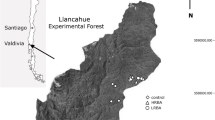Abstract
Mediterranean ecosystems are traditionally influenced by human disturbance. In the mountain chains of south-eastern Spain, holm oak forests representing the potential natural vegetation are currently highly fragmented and subjected to extensive grazing by goats and sheep. This grazing activity by large herbivores has important impacts on community structure and dynamics of the remaining remnants because several processes associated with reproduction are affected. The present research analyses the variation of stand structure and regeneration of six forests dominated by Quercus ilex along a gradient of increasing grazing intensity. Stands of higher grazing intensity are characterized by a lower trunk number. Particularly, trees > 1.3 m height and diameter classes < 20 cm are clearly less represented. In addition, more intensively grazed forests show a highly aggregated dispersion of trees, which might be explained by an increase of clonally produced ramets by silvipastoral use. On the other hand, no Quercus ilex seedlings were found in any of the stands examined, although acorn production was high and did not correlate with grazing intensity. However, grazing clearly influences the quality of acorn harvest. We found a significant negative correlation between acorn length, acorn mass and grazing intensity and a positive correlation between the percentage of aborted acorns, acorn predation and herbivore activity. Thus, management of grazing in holm oak forests must take the high influence that livestock exerts on the regeneration of Quercus ilex into account, and maximum sustainable grazing intensity should be significantly lower than 0.8 animals per ha.
Similar content being viewed by others
References
Bacilieri R., Bouchet M.A., Bran D., Grandjanny M., Maistre M., Perret P. and Romane F. 1993. Germination and regeneration mechanisms in Mediterranean degenerate forests. J. Veg. Sci. 4: 241–246.
Bakker J.P. 1998. The impact of grazing on plant communities. In: Wallis de Vries M., Bakker J.P. and van Wieren S.E. (Eds.), Grazing and conservation management. Kluwer Academic Publishers, Dordrecht, pp. 137–155.
Barbéro M., Bonin G., Loisel R. and Quézel P. 1990. Changes and disturbances of forest ecosystems caused by human activities in the western part of the mediterranean basin. Vegetatio 87: 151–173.
Begon M.E., Townsend C.R. and Harper J.L. 1996. Ecology, 3rd ed. Blackwell Scientific Publications, Oxford.
Bellon S. and Guérin G. 1992. Old holm oak coppices... new silvopastoral practices. Vegetatio 99-100: 307–316.
Bilbrough C.J. and Richards J.H. 1993. Growth of sagebrush and bitterbrush following simulated winter browsing: mechanisms of tolerance. Ecology 74: 481–492.
Bran D., Lobréaux O., Maistre M., Perret P. and Romane F. 1990. Germination of Quercus ilex and Q. pubescens in a Q. ilex coppice. Long-term consequences. Vegetatio 87: 45–50.
Bussotti F. and Grossoni P. 1998. Des Problèmes dans la classification des chênes. Taxonomie en Europe et région méditerranéenne. Forêt Méditerranéenne 19: 267–278.
Canadell J., Djema A., López B., Lloret F., Sabaté S., Siscart D. and Gracia C.A. 1999. Structure and dynamics of the root system. In: Rodà F., Retana J., Gracia C.A. and Bellot J. (Eds.), Ecology of Mediterranean Evergreen Oak Forests. Ecol. Stud. 137. Springer Verlag, Berlin, Heidelberg, pp. 47–59.
Cierjacks A., Hensen I. and Sanchez P. 2002. Effects of grazing on the species composition in a holm oak forest community of south-eastern Spain (Adenocarpo decorticantis-Quercetum rotundifoliae Rivas Martínez 1987). Bot. Jahrb. Syst. 123: 447–461.
Clark J.P. and Evans F.C. 1954. Distance to nearest neighbor as a measure of spatial relationships in populations. Ecology 35: 445–453.
Cuartas P. and García-Gónzalez R. 1992. Quercus ilex browse utilisation by caprini in Sierra de Cazorla and Segura (Spain). Vegetatio 99-100: 317–330.
Debussche M., Debussche G. and Lepart J. 2001. Changes in the vegetation of Quercus pubescens woodland after cessation of coppicing and grazing. J. Veg. Sci. 12: 81–92.
DeGange A.R., Fitzpatrick J.W. and Layne J.N. 1989. Acorn harvesting by Florida Scrub Jays. Ecology 70: 348–356.
Ducrey M. and Boisserie M. 1992. Recrû naturel dans des taillis de chêne vert (Quercus ilex L.) à la suite d´exploitations partielles. Ann. Sci. For. 49: 91–109.
Ducrey M. and Toth J. 1992. Effect of cleaning and thinning on height and girth increment in holm oak coppices (Quercus ilex L.). Vegetatio 99-100: 365–376.
Fernandez Alés R., Laffarga J.M. and Ortega F. 1993. Strategies in Mediterranean grassland annuals in relation to stress and disturbance. J. Veg. Sci. 4: 313–322.
Floret C., Galan M.J., Le Floc´h E. and Romane F. 1992. Dynamics of holm oak (Quercus ilex L.) coppices after clearcutting in southern France. Flora and life cycles changes. Vegetatio 99-100: 97–105.
GomezSal A., De Miguel J.M., Casado M.A. and Pineda F.D. 1986. Successional changes in the morphology and ecological responses of a grazed pasture ecosystem in Central Spain. Vegetatio 67: 33–44.
Graetz R.D. and Tongway D.J. 1986. Influence of grazing management on vegetation, soil structure and nutrient distribution and the infiltration of applied rainfall in a semi-arid chenopod shrubland. Austr. J. Ecol. 11: 347–360.
Hensen I. 1995. Die Vegetation von Polylepis-Wäldern der Ostkordillere Boliviens. Phytocoenologia 25: 235–277.
Hensen I. 2002. Impacts of anthropogenic influence on the vegetation of Polylepis woodlands in the region of Cochabamba/Bolivia. Ecotropica 8: 183–203.
Hunt L.P. 2001. Low seed availability may limit recruitment in grazed Atriplex vesicaria and contribute to its local extinction. Plant Ecol. 157: 53–67.
Ibañez J.J., Lledó M.J., Sánchez R. and Roda F. 1999. Stand structure, aboveground biomass and production. In: Rodà F., Retana J., Gracia C.A. and Bellot J. (Eds.), Ecology of Mediterranean Evergreen Oak Forests. Ecol. Stud. 137. Springer Verlag, Berlin, Heidelberg, pp. 31–45.
ICONA Ministerio de Agricultura Pesca y Alimentación 1990. Mapa forestal de España. Escala 1:200.000. Hoja 6-11: Almería. Madrid.
Joffre R., Rambal S. and Ratte J.P. 1999. The dehesa system of southern Spain and Portugal as a natural ecosystem mimic. Agrofor. Systems 45: 57–79.
Keeley J.E. 1992. Recruitment of seedlings and vegetative sprouts in unburned chaparral. Ecology 73: 1194–1208.
Keeley J.E. 1998. Coupling demography, physiology and evolution in Chaparral Shrubs. In: Rundel P.W., Montenegro G. and Jaksic F.M. (Eds.), Landscape Disturbance and Biodiversity of Mediterranean-type Ecosystems. Ecol. Stud. 136. Springer Verlag, Berlin, Heidelberg, pp. 257–264.
Kerley G.I. and Whitford W.G. 2000. Impact of grazing and desertification in the Chihuahuan Desert. Plant community, granivores and granivory. Amer. Midl. Nat. 144: 78–91.
Kramer H. and Akca A. 1995. Leitfaden zurWaldmeßlehre. 3. Aufl. J. D. Sauerländer´s Verlag, Frankfurt a. M.
Leiva M.J. and Ales R.F. 2000. Effect of grazing on the population of Phalaris aquatica. J. Rangel. Manag. 53: 277–281.
Li J. and Romane F.J. 1997. Effects of germination inhibition on the dynamics of Quercus ilex stands. J. Veg. Sci. 8: 287–294.
Michaud H., Lumaret R. and Romane F. 1992. Variation in the genetic structure and reproductive biology of holm oak populations. Vegetatio 99-100: 107–113.
Obeso J.R. 1993. Does defoliation affect reproductive output in herbaceous and woody plants in different ways? Funct. Ecol. 7: 150–155.
Retana J., Riba M., Castell C. and Espelta J.M. 1992. Regeneration by sprouting of holm-oak (Quercus ilex) stands exploited by selection thinning. Vegetatio 99-100: 355–364.
Retana J., Espelta J.M., Gracia M. and Riba M. 1999. Seedling Recruitment. In: Rodà F., Retana J., Gracia C.A. and Bellot J. (Eds.), Ecology of Mediterranean Evergreen Oak Forests. Ecol. Stud. 137. Springer Verlag, Berlin, Heidelberg, pp. 89–103.
Robles A.B. 1990. Evaluación de la oferta forrajera y capacidad sustentadora de un agrosistema semiárido del sureste Ibérico. Ph.D. Thesis, University of Granada, Spain.
Santos T. and Tellería J.L. 1997. Vertebrate predation on holm oak, Quercus ilex, acorns in a fragmented habitat: effects on seedling recruitment. For. Ecol. Manag. 98: 181–187.
Siscart D., Diego V. and Lloret F. 1999. Acorn Ecology. In: Rodà F., Retana J., Gracia C.A. and Bellot J. (Eds.), Ecology of Mediterranean Evergreen Oak Forests. Ecol. Stud. 137. Springer Verlag, Berlin, Heidelberg, pp. 75–87.
Terradas J. 1999. Holm oak and holm oak forests: An introduction. In: Rodà F., Retana J., Gracia C.A. and Bellot J. (Eds.), Ecology of Mediterranean Evergreen Oak Forests. Ecol. Stud. 137. Springer Verlag, Berlin, Heidelberg, pp. 3–14.
Wilmanns O. and Müller K. 1977. Zum Einfluß der Schaf-und Ziegenbeweidung auf die Vegetation im Schwarzwald. In: Tüxen R. (Ed.), Vegetation und Fauna. Ber. Int. Symp. IVV Rinteln. J. Cramer Verlag, Vaduz, pp. 465–479.
Author information
Authors and Affiliations
Corresponding author
Rights and permissions
About this article
Cite this article
Cierjacks, A., Hensen, I. Variation of stand structure and regeneration of Mediterranean holm oak along a grazing intensity gradient. Plant Ecology 173, 215–223 (2004). https://doi.org/10.1023/B:VEGE.0000029322.75004.ad
Issue Date:
DOI: https://doi.org/10.1023/B:VEGE.0000029322.75004.ad




